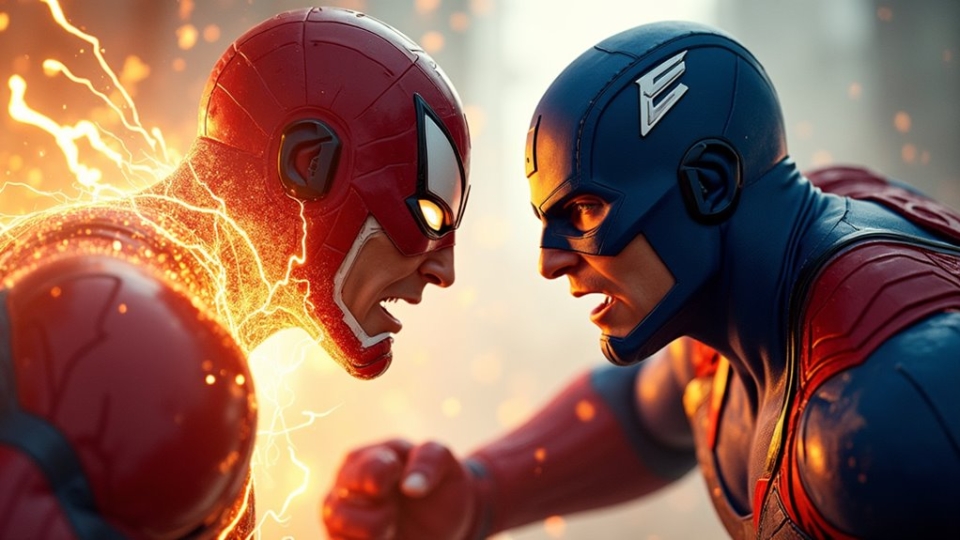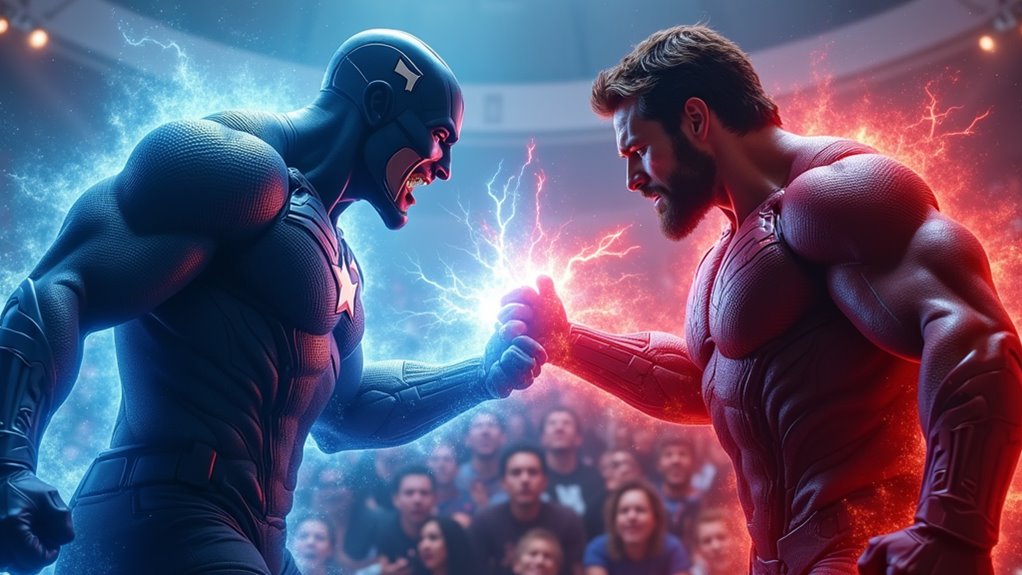
Marvel Rivals Best Pro Matches to Learn Strategy
Rise of the Titans: Analyzing the Epic Showdown
As the titans clashed in the ring, you couldn't help but feel the palpable tension that electrified the atmosphere.
 Each fighter was keenly aware of their tactical advantages, using every move to outmaneuver their opponent. You noticed how they capitalized on positioning and timing, turning the tide of the battle with calculated strikes. This wasn’t just a physical confrontation; it was a masterclass in psychological warfare.
Each fighter was keenly aware of their tactical advantages, using every move to outmaneuver their opponent. You noticed how they capitalized on positioning and timing, turning the tide of the battle with calculated strikes. This wasn’t just a physical confrontation; it was a masterclass in psychological warfare.
You saw how feints and mind games played a crucial role, as one titan baited the other into a trap, exploiting overconfidence. It’s not enough to be powerful; understanding your opponent's psyche can lead to victory. The subtle shifts in their expressions and body language revealed layers of strategy at play. Ultimately, recognizing these dynamics helps you appreciate the depth of the showdown, illustrating that in the world of titans, intellect often triumphs over brute strength.
Strategic Mastery: Key Character Picks and Their Impact
When it comes to winning matches, your character selection can make or break your strategy. Choosing characters that complement each other not only enhances your offensive and defensive capabilities but also creates unexpected synergies. Understanding the nuances of these picks can give you a significant edge over your opponents.
Optimal Character Selection
Choosing the right character in Marvel Rivals can significantly influence your match's outcome. Understanding character strengths and how they align with your playstyle is crucial. Each character has unique abilities, and a solid matchups analysis can help you determine which characters excel against specific opponents. For instance, if you’re facing a heavy-hitter, selecting a character with strong defensive capabilities could tilt the odds in your favor. Additionally, consider the meta; certain characters might be more viable due to recent balance changes. By evaluating both your strengths and your opponent's weaknesses, you can make informed decisions that enhance your strategic advantage. Ultimately, optimal character selection is about leveraging advantages while minimizing risks in every matchup.
Synergistic Team Composition
Optimal character selection lays the groundwork for a successful strategy, but the real power comes from how those characters work together. Understanding team synergy is essential in maximizing your team's potential. Each character role must complement the others to create a cohesive unit.
- Tank: Absorbs damage and protects teammates.
- Support: Heals and enhances allies' abilities.
- Damage Dealer: Focuses on inflicting maximum damage to opponents.
- Crowd Control: Disrupts enemy strategies and creates openings.
- Flex: Adapts to different roles based on match dynamics.
Combos That Conquer: Breakdown of Game-Changing Moves
When analyzing game-changing moves, you’ll want to focus on essential combo techniques that can turn the tide of a match. Understanding high-damage strategies not only maximizes your character's potential but also keeps your opponent on the defensive. By mastering these combos, you’re significantly increasing your chances of victory in high-stakes situations.
Essential Combo Techniques
Mastering essential combo techniques can elevate your gameplay, transforming average matches into spectacular victories. By understanding combo extensions and character synergies, you’ll create powerful sequences that leave your opponents reeling. Here are some techniques to focus on:
- Chaining Attacks: Link moves seamlessly to maintain pressure.
- Use of Special Moves: Incorporate special attacks for increased damage and flair.
- Timing and Precision: Execute combos with perfect timing to maximize damage output.
- Character Synergies: Combine characters effectively to enhance combo potential.
- Adaptability: Adjust your combos based on your opponent’s playstyle and weaknesses.
Embracing these techniques will not only improve your skill but also your strategic depth, giving you the upper hand in competitive matches.
High-Damage Strategies Explained
Building on the foundation of combo techniques, high-damage strategies can turn the tide of battle in your favor. To maximize your effectiveness, it’s crucial to understand high damage techniques that exploit your opponent’s weaknesses. Look for opportunities to chain moves that enhance damage optimization, utilizing character strengths and environmental factors. For instance, initiating with a launcher followed by aerial combos can amplify your damage output. Always stay aware of your opponent's positioning; a well-timed counter can shift the momentum dramatically. Additionally, incorporate special moves that deal significant damage while offering defensive options. Mastering these strategies not only increases your damage potential but also keeps your opponent on the defensive, creating openings for further attacks. Embrace these tactics to dominate the battlefield.
Reading the Opponent: The Art of Anticipation
While many players focus on their own moves, truly great competitors understand that reading their opponents is crucial to success. This skill involves more than just observation; it’s about anticipating actions and adapting your strategy accordingly. By honing your ability to read body language, you can predict potential moves and set up effective counter strategies.
Consider these key points:
- Exploiting weaknesses: Identify your opponent’s flaws and capitalize on them.
- Mental game: Maintain composure to influence their decisions.
- Timing attacks: Execute moves when they’re least expected.
- Pressure management: Apply pressure to force mistakes and openings.
- Spacing techniques: Control the distance to dictate exchanges.
Positioning and Movement: Navigating the Battlefield
Effective positioning and movement are essential components of any competitive match, as they allow you to control the flow of battle and dictate engagements. Mastering spacing techniques can create opportunities to avoid incoming attacks while setting up your own strikes. Whether it’s maintaining distance to bait opponents or closing the gap to capitalize on a vulnerability, your movement should always serve a strategic purpose.
Additionally, leveraging terrain advantages can significantly enhance your effectiveness. High ground can provide a tactical edge, allowing for better visibility and attack angles. Meanwhile, using obstacles for cover can shield you from damage while enabling you to flank your opponent.
Always be aware of your surroundings and adapt your positioning based on the battlefield layout. Remember, the key to winning lies not just in your character's abilities, but also in how you navigate the space around you. Control the battlefield, and you'll control the match.
Adaptation in Action: Responding to Opponent Strategies
Adapting to your opponent's strategies is crucial if you want to maintain an edge in competitive matches. Successful players constantly analyze their adversaries, implementing counter strategies and adaptive tactics. Here are some key points to consider:
- Identify Patterns: Notice your opponent's moves and habits. Understanding their tendencies can help you exploit weaknesses.
- Experiment with Tactics: Don’t hesitate to change your approach mid-match. Flexibility can disorient your opponent.
- Focus on Defense: Sometimes, playing defensively can bait your opponent into making mistakes, allowing for a perfect counter.
- Utilize Mind Games: Create uncertainty by feigning aggression or retreat. This can provoke hasty decisions from your rival.
- Stay Calm Under Pressure: Maintaining composure enables clearer thinking, making it easier to adapt to unexpected strategies.
Turning Points: Moments That Changed the Course of Matches
In competitive matches, pivotal moments can dramatically shift the tide of battle, often determining the outcome long before the final whistle. Recognizing these turning points is crucial for any player. For instance, an unexpected combo or a well-timed counter can destabilize your opponent, swinging match momentum in your favor.
Consider the psychological impact of a significant play; it can lead to overconfidence or hesitation in your opponent. When you capitalize on these moments, you not only gain an advantage but also dictate the pace of the match.
Strategically, it's vital to remain aware of potential turning points throughout your gameplay. Analyze your opponent's reactions, and be prepared to exploit any missteps. By honing your ability to identify and leverage these moments, you’ll enhance your overall strategy and improve your chances of clinching victory when it matters most.
Frequently Asked Questions
What Are the Best Beginner Characters to Start With in Marvel Rivals?
For beginners, characters like Spider-Man and Captain America offer solid strengths. Their abilities help you grasp fundamental strategies, focusing on mobility and defense, making it easier to learn the game and develop your skills effectively.
How Can I Improve My Reaction Time During Matches?
To improve your reaction time, incorporate reaction drills and timing exercises into your practice routine. Focus on predicting your opponent’s moves and responding swiftly; this’ll sharpen your instincts and enhance your overall performance in matches.
Are There Specific Training Modes to Practice Combos Effectively?
Yes, there're effective combo training modes available. Use these to practice specific sequences repeatedly, breaking them down into manageable sections. Analyzing your execution can significantly enhance your overall performance and mastery of the game.
What Are Common Mistakes to Avoid in Competitive Play?
In competitive play, avoid neglecting strategic positioning and poor resource management. These mistakes can lead to missed opportunities and unnecessary losses. Always prioritize maintaining control of the battlefield and efficiently using your resources during matches.
How Do I Analyze My Performance After a Match?
To analyze your performance after a match, track performance metrics like win rates and decision-making efficiency. Use self-assessment techniques, such as reviewing key moments and identifying patterns, to refine your strategy and improve future outcomes.










